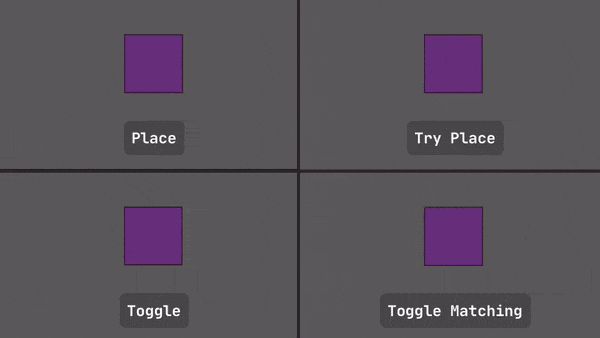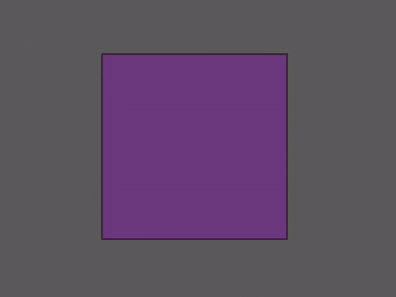3 unstable releases
| 0.5.0 | Apr 24, 2022 |
|---|---|
| 0.4.1 | Feb 17, 2022 |
| 0.4.0 | Feb 17, 2022 |
#1396 in Game dev
43KB
840 lines
bevy_tileset_map
An implementation of bevy_tileset for
the bevy_ecs_tilemap crate.

📋 Features
All features from bevy_tileset, including:
- Define tilesets and tiles via RON files
- Load a tileset directly as a Bevy asset
- Define Standard, Animated, Variant, and Auto tiles
As well as features specific to this crate:
- Super easy serialization and deserialization
- Auto tiling support
- Compact tile placement/removal
📲 Installation
This crate is still not publicly released yet as I might want to make a PR to try and integrate it directly
with bevy_ecs_tilemap, but for now you can use it with git:
[dependencies]
bevy_tileset_map = "0.5"
# Don't forget to add `bevy_ecs_tilemap` to your project!
bevy_ecs_tilemap = "0.6"
✨ Usage
🧩 Tilesets
For info on how to define and use tilesets, check out the README
for bevy_tileset. This crate re-exports the entire crate under the tileset submodule.
To use this crate, make sure you add the following to your app:
use bevy::prelude::*;
use bevy_tileset_map::prelude::{TilesetPlugin, TilesetMapPlugin};
use bevy_ecs_tilemap::prelude::TilemapPlugin;
fn main() {
App::new()
// ...
// bevy_ecs_tilemap
.add_plugin(TilemapPlugin)
// bevy_tileset
.add_plugin(TilesetPlugin::default())
// bevy_tileset_map
.add_plugin(TilesetMapPlugin)
// ...
.run();
}
💾 Serialization/Deserialization
With the
serializationfeature enabled
With this crate, serialization is very simple (as long as your tiles are generated using tilesets).
Simply add the TilemapSerializer to your system:
/// Assumes bevy_ecs_tilemap has already been properly setup to have tiles read from it
fn save_maps(serializer: TilemapSerializer) {
// This saves all currently generated maps
let maps = serializer.save_maps();
// Write to disk using something like serde_json...
}
And deserializing is just as simple:
/// Assumes bevy_ecs_tilemap has already been properly setup to have tiles placed into it
fn load_maps(mut serializer: TilemapSerializer) {
let path = FileAssetIo::get_root_path().join("assets/map.json");
let data = std::fs::read_to_string(path).unwrap();
let maps = serde_json::from_str::<SerializableTilemap>(&data).unwrap();
serializer.load_maps(&maps);
}
Check out the serialization example to see how we turn some JSON into a full tilemap. Again, as long as you set everything up using tilesets, it should work pretty much as expected.
Note: This feature is very barebones and partially experimental. If things aren't working like you want, feel free to submit an issue or PR about it!
🏗 Placement/Removal

One of the nice features about this crate is that it provides some built-in tile placement/removal logic so you don't have to! This can easily be accessed using the TilePlacer system param.
fn place_tile(mut placer: Tileplacer, /* ... */) {
// ...
placer.place(
tile_id,
tile_pos,
map_id,
layer_id
);
}
Easy!
Plus it comes with other variants the place method (with all the same properties). So give them a try!
🧠 Auto Tiling

While bevy_tileset adds the ability to define Auto Tiles, this crate actually puts it to use.
Using the aforementioned TilePlacer system parameter makes handling auto tiles a breeze! Besides simply handling the placement code, internally this handles multiple things related to auto tiles:
- When placing a tile, it automatically inserts the required
AutoTilecomponent - If a tile needs to be removed and it's an auto tile, the removal process is also automatically taken care of
If you decide you want to do this manually, make sure you properly handle the placement/removal process. When placing you must add the AutoTile component (so the AutoTiler knows it exists). And when you remove an auto tile, make sure you send a RemoveAutoTileEvent event (otherwise surrounding auto tiles won't know to update).
Just remember that auto tiles can be slow, so thousands of them may result in lag when first placed (this can be mitigated by avoiding very large batch placements). However, once placed, they don't need to be updated anymore, so it shouldn't affect performance after that.
🎓 Examples
Check out the examples for bevy_tileset for tileset-specific
examples.
- clickable - Add and remove tiles using
bevy_ecs_tilemapandbevy_tileset_map - serialization - Load a tilemap from JSON
- drag - Click and drag to add or remove tiles
🕊 Bevy Compatibility
| bevy | bevy_tileset_map |
|---|---|
| 0.7 | 0.5 |
| 0.6 | 0.4 |
| 0.5 | 0.2 |
ℹ️ FAQ
Why is this not just a feature on bevy_ecs_tilemap or bevy_tileset?
The main reason for this is that those crates are meant to be generally used, whereas this one is meant to be more specific in usage: it's for those who want to use both crates together.
Dependencies
~41–55MB
~1M SLoC